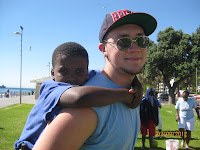We took a ferry out to Robben Island on Wednesday morning to visit the prison where Nelson Mandela was held for 17 years. The seas were a bit rough on our ride over because the winds were up that day. A thirty minute ferry ride took us across the bay. From the landing area, we boarded a tour bus that drove us to the Prison.
Our tour guide at the prison was a former prisoner during the apartheid era. He walked us through the grounds of the prison and led us into a large room that housed fifty prisoners (it was large, but certainly not spacious when you imagine 50 men were held there). He told us about the living conditions in this room and the procedures that the guards used to classify the inmates. We learned so much that day about the leaders who fought against apartheid from his stories. He gave us time to ask questions at the end of his talk. I was surprised that my students didn't speak up at this point; my group is not shy. But, like me, they seemed to be feeling overwhelmed by the stories we had just heard. From this large cell, we walked out into the area that is referred to as Mandela's Garden, which is where inmates were forced to break rocks or sew bags for hours each day. This area was the only place that included a picture of the conditions at the prison. In the picture you can see a row of men tied to the ground, spread about four feet apart, hammering rocks, and a second row of men with a pile of bags, working in the hot sun. From the garden, we walked down the hall of solitary confinement cells, with a stop at Nelson Mandela's jail cell.
Our last stop on the tour was another large cell with rows of benches. We all sat down to hear the story about the release of the prisoners and the negotiations for freedom. He told us that hate was not the answer to the struggle; the only way to move forward was through education and forgiveness. Our tour guide sent us away with the charge to pass along what we have learned here at Robben Island. I was moved to tears by his request. It hit me at that moment that the struggle for freedom from oppression was a responsibility for all of us, and not reserved for former prisoners or political leaders in South Africa.
We said our goodbyes to the tour guide and loaded back onto the tour bus. Next we were given a driving tour around the rest of the island. We drove past the solitary confinement area of Robert Sobukwe, who led the country in protests against the "dumb pass", a pass that all black people were required to go anywhere. Before it was a prison, Robben Island was also used as a leper colony. A small stone church is the only building left standing from that part of the Island's history; all the other buildings were burned. There is a small community of about 100 people who live on Robben Island today. We drove through this small neighborhood, with a stop at the point with an amazing view of Cape Town for some photos. On the back side of the island, we saw cannons from World War II that were used to shoot down German ships. The driving tour concluded back at the ferry landing. We boarded the ferry for an even bumpier ride back over to Cape Town.




































